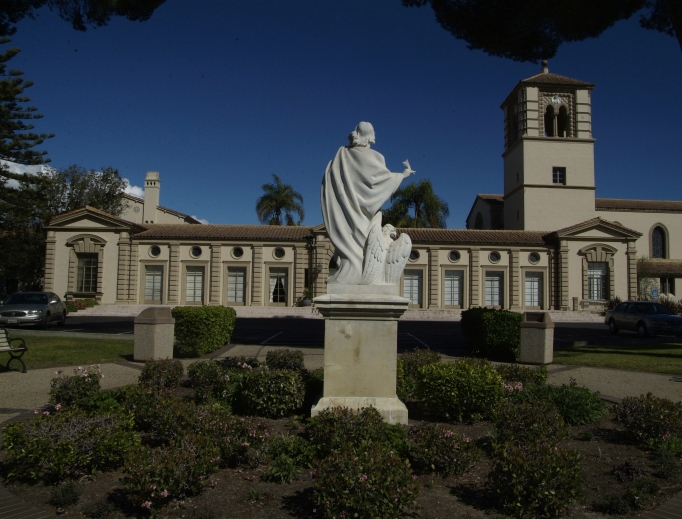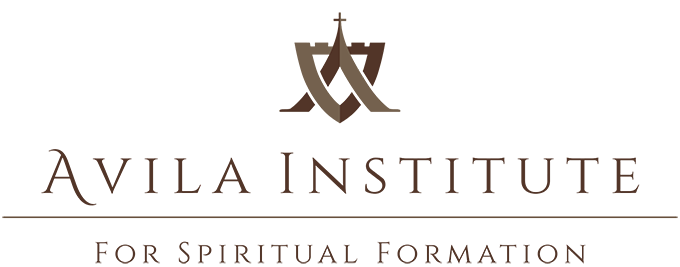Path to Answer the High Calling: New Program for Future Seminarians Pilots in LA
Avila Institute’s preparation program is at the end of the piloting phase in the Archdiocese of Los Angeles.

Is there such a thing as a “typical seminarian”?
“Guys are coming from all different walks of life — so what’s the typical candidate for vocations?” asks Father Sam Ward, associate director of vocations for the Archdiocese of Los Angeles.
“Thirty or 40 years ago, he was from a solid Catholic family, an altar boy who went to Catholic school. Now we have guys in discernment who are coming out of a Catholic high school; guys in their 30s, 40s, even 50s; from different socioeconomic backgrounds.
“Some were raised in very, very traditional, solid Catholic families; some have been away from the faith a long time. We have converts; reverts; some who are very well catechized and evangelized, who know the faith well. Some have really strong prayer lives, but don’t know the faith.”
This diversity makes for a rich culture among seminarians and — ultimately — a diverse priesthood. But it also makes for a great challenge in priestly formation.
Men need help filling gaps in their catechesis, help building a rich prayer life and help overcoming the challenges that today’s society pushes upon us all.
And that’s where propaedeutic formation comes into the picture.
The Need for a New Ratio
In December 2016, Pope Francis issued updated guidelines for priestly formation called Ratio Fundamentalis Institutionis Sacerdotalis (The Gift of Priestly Vocation). In it, the Holy Father observes that men need more thorough preparation before entering into seminary and directs that “propaedeutic” (preparatory) formation be offered to them. (The ratio was originally promulgated in January 1970 and was amended in 1985 by Pope John Paul II.)
“A propaedeutic year is an introductory phase of formation. ‘Propaedeutic’ means introductory,” explained Anthony Lilles, academic dean at St. John’s Seminary in Camarillo, California.
“It comes before they begin their studies of philosophy or theology. It’s a time of preparation.”
“John Paul II, over 30 years ago, first saw the need for this introductory formation, and Pope Francis said: ‘Yes, there’s not only a need; we must implement this introductory period now.’”
The period of formation, meant to validate the vocation, is vitally important, explained Cardinal Beniamino Stella in an interview with Vatican Radio — yet fitting it in is a challenge.
Rome requires two years of philosophy and four years of theology; seminarians may also have a parish internship, bringing their priestly formation to a total of seven years — or longer, if any remedial work needs to be done.
“So how do we present the propaedeutic formation period in a way that honors everything [it] is intended to do by the Church, but at the same time doesn’t increase the length of formation even more than it is already stretched out?” asked Lilles.
“It’s a very serious question.”
Lilles had some thoughts on the subject, which he took to Dan Burke, founder of the Avila Institute for Spiritual Formation, an online institute for spiritual formation, and executive director of the Register. Together, they decided to explore how they could serve the Church by adding a propaedeutic program to St. John’s preparatory formation.
Now the Avila Institute’s “High Calling Seminary Preparation Program” is at the end of the piloting phase with a group of men in the Archdiocese of Los Angeles. “The pilot phase has been an overwhelming success according to the vocation directors and students,” said Burke after a recent evaluation meeting with the vocation directors. He also recounted that the “vocation directors were particularly pleased with the flexibility of the program, in that it enabled men to stay engaged in their discernment as they ramp down their jobs, pay off their debt or finish their degrees. One future seminarian even engaged in the online studies as he served in the U.S. military in Syria.”
In the pilot, 12 men have engaged in six courses, ranging from “Missionary Discipleship and the Seminary Community: An Introduction to Seminary” to “St. Teresa of Avila and Mental Prayer.” And already, Lilles said, “They have started to form a community.”
Fellowship and Faith
Although the program takes place online, the goal is to recreate the collegial classroom experience that is so important in higher education. “Our goal isn’t simply informational. Our goal is formational,” said Lilles. “It’s a goal to help them enter into the human and spiritual and pastoral formation, in addition to the theological formation that is a part of seminary life.”
And, while he believes in the goals of the program, he admits that he was not certain how well those goals could be achieved via a digital classroom. He wondered if spiritual truths and personal encounters with Christ could be facilitated by technology, or if technology would actually get in the way of such faith development.
But what he’s seen, he said, is that “technology can facilitate a very meaningful conversation that can help men enter more fully into being a disciple of Jesus.”
“We’ve been able to make this encounter with the students authentic and a moment of communion.”
In fact, the fellowship fostered online continues to grow in real life, as Lilles has observed for himself.
In mid-October 2017, St. John’s Seminary hosted a priestly discernment retreat that many of the “High Calling” participants attended. When Lilles observed the enthusiasm with which program participants greeted each other, he realized that — although they had never encountered each other face-to-face before — they had already begun to form a community in their digital class. And, said Lilles, “That kind of community is absolutely essential for priestly formation.”
For Dimitri Serrano, 25, a first lieutenant stationed overseas with the Army, “High Calling” makes a propaedeutic program — and a sense of community — possible. Being stationed “in the middle of nowhere,” he was concerned, first of all, that he might not have regular access to Mass and the sacraments; secondly, he wondered how he would pursue his process of discernment.
The presence of a Catholic chaplain eased the first concern. Serrano is able to attend Mass every Sunday and serves as a lector and extraordinary minister of Holy Communion. “High Calling” eased the second concern.
“Right now we’re learning about prayer — what prayer is and what prayer isn’t,” he said by way of example. “I’ve never had that type of instruction. We’re going back to what the Church teaches about prayer.”
And though he’s sometimes unable to meet with his classmates face-to-face while he’s stationed overseas, the sense of community encompasses him, too, he said.
“The other week I was sick, and I still did the course, and one of the guys private-messaged me: ‘You look a little sick. Get well soon!’ Another guy private-messaged me: ‘Get well soon’ [too].
“They’re encouraging!”
Lilles theorizes that vocations directors might need to adjust to the idea of a digital program like this one, but for Father Stephen Davoren, director of vocations for the Archdiocese of Los Angeles, it seemed like an ideal solution.
While Rome has suggested adding a propaedeutic year of formation to the already lengthy priestly formation schedule, Father Davoren says simply, “There’s no way we can ask this.”
But the opportunity to add this type of support system, an additional avenue of discernment, to a year preparing to enter seminary resonated with him.
A former Los Angeles police officer, Father Davoren was an alumnus of Catholic schools — yet his knowledge of Catholicism was rather patchy when he began discerning his vocation to the priesthood. “This would have been a blessing for me back then,” he said of “High Calling.”
A Contemporary Challenge
While today’s technology may facilitate propaedeutic formation, contemporary society makes it so necessary.
For instance, Lilles pointed out, “High Calling” participants hail from across the Archdiocese of Los Angeles, which is a vast territory filled with traffic snarls. Some are college students; some are professionals who work full time; and Serrano is on another continent. It would be literally impossible for all of them to come together, even on a weekly basis.
But thanks to the digital format, Lilles said, “they found this time to be together and share ideas and share their witness of how God is working in their lives.”
Each class meeting is a live-interactive video conference. The Avila Institute’s learning management system enables participants to see and speak with one another and participate in forums and other means of discussion with each other. That’s also where they journal, an important component of the program, intended to deepen and broaden conversation with their vocations directors.
One to two new modules launch each month, each lasting about three weeks. The three levels of the program span from an introduction to seminary and the transition from contemporary culture to the culture of the seminary, to reading through the whole of sacred Scripture to understand the bigger picture of salvation history, and looking at great works of art and literature and how they reveal profound existential questions.
“Besides the breadth of the curriculum ‘High Calling’ offers these young men in their introductory year,” notes Lilles, “we’ve put together a remarkable body of faculty members from across the country to teach that material in a way that’s most engaging. Students take courses on sexual morality, for instance, from renowned theology of the body experts Dr. Pia de Solenni and Father Sean Kilcawley. Christopher Carstens teaches a module on the liturgy. Dan Burke teaches on the interior life.”
But even with an all-star faculty, the “High Calling” program has maintained a personal approach, designed to introduce young men into the formal processes of discernment and formation without overwhelming them.
“We believe this will supplement other propaedeutic work that seminaries are developing right now, so there is a healthy transition into seminary life,” said Lilles.
“Our thought is the smoother we can make that transition, the greater likelihood the men will be able to benefit from their formation sooner; sometimes men don’t benefit from their formation right away because of sort of ‘shell shock.’”
For Serrano, who hopes to enter seminary in 2019 — after his four-year-contract with the Army has been completed and he has resigned from active duty — the prospect of life in community feels comfortable: After all, he’ll be coming from the military, where he and his colleagues rely on each other to complete their mission. But continued learning about his faith, and stepping farther along the road of discernment, is a powerful experience.
“I would tell anyone, ‘If you have an opportunity to join a course like this, take it,’” he said. “Give it a shot. You’re going to learn a lot about yourself!”
Elisabeth Deffner writes from Orange, California.


















